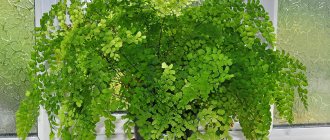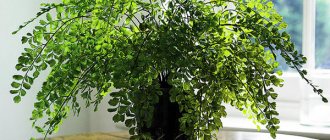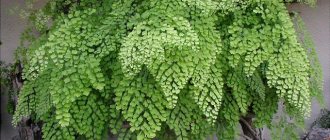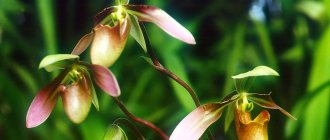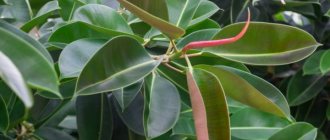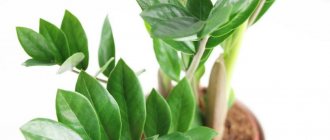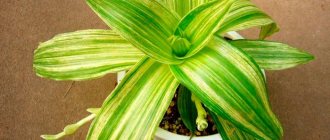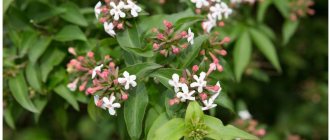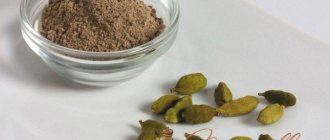The houseplant adiantum is a perennial fern of the family of the same name, universally loved by connoisseurs of indoor plants for its special tenderness and airiness. Its branches can often be found in wedding bouquets. The lacy foliage of this fern has a special property - it repels water without getting wet, which is why it got its name (translated from Greek as “not to wet”). Caring for adiantum at home is not difficult, but it has its own special rules that you need to know and strictly follow.
What does Venus hair look like, what family does it belong to?
Venus hair (Adiantum capillus-veneris) is usually classified as a member of the genus of ferns, family Pteris. This perennial is characterized by the fact that its leaves are able to repel water.
Adiantum venereal hair
In appearance, the flower is a herbaceous plant 30-40 cm in height with a thin creeping rhizome and openwork leaves, colored bluish or bright green. The leaf blades on a long brown petiole (25 cm in length) can be arranged alternately or oppositely. The sheets have a highly dissected plate with many soft segments.
On a note! With good care, a flower can live at home for more than 10 years.
Common varieties
The most popular types of adiantums for keeping in homes:
- stop-shaped;
- gentle;
- fine-haired;
- Ruddy;
- Beautiful;
- caudate.
Medicinal properties
The leaves of the flower are used to prepare powders and syrups that have expectorant, antipyretic and antimicrobial effects. The tincture is used to treat psoriasis, and dandruff is eliminated using a decoction of adiantum.
Briefly about the history of appearance
The distribution area of this fern is considered to be Brazil and the forests of South America. Wild species can be found in natural conditions in the Caucasus and Crimea. Houseplants are distributed throughout the world.
Pests
In general, adiantum is quite resistant to pests, however, you need to be prepared to fight them. Treatment is problematic, since fern treatment with chemicals is difficult to tolerate. In case of danger of infection, it is better to take care of isolation in a timely manner.
Mealybug and whitefly
It is better to start the fight with folk remedies, for example, with garlic or soap solution. Among insecticides against whiteflies, a composition based on pyrethrum is effective. The scale insects are removed mechanically by scraping off the back of the leaves and stems, after which the deposited larvae are destroyed using insecticides.
Traces of mealybugs can easily be confused with spores of the adiantum itself. However, the spores are arranged in even rows, and the parasites are arranged in random clusters.
Spider mite
Damage is possible if kept in too dry a room. Signs of it are the appearance of cobwebs, leaf lethargy and subsequent falling off. Don’t immediately jump to chemical means of control. Carefully remove as much cobwebs as possible, rinse the plant in a warm shower and take steps to increase the humidity in the room.
Hairy aphid
A symptom of damage is the formation of fluffy spots on the leaves. To fight, denatured alcohol is used. You need to treat the affected areas with a brush, being careful not to touch the healthy parts of the plant.
Features of plant care at home
A distinctive feature of the flower is its rapid growth. This is not difficult to achieve. Venus hair is a flower that does not have high care requirements.
Temperature
Akalifa - home care and description
The optimal temperature for good flower growth is +16… +20 ºС. The plant can withstand cold temperatures down to +10 ºС, but lower temperatures lead to the death of leaves.
Additional Information. A fern pot should not be placed near radiators or heaters.
Lighting
The abundance of sun negatively affects the growth and condition of the flower. In the wild, ferns are most often found in shady areas. At home, suitable conditions for placing a flower will be windows facing east or north. In rooms facing west, it is better to remove the flowerpot from the windowsill into the back of the room.
Lighting the flower of lady's hair
Watering
The frequency of watering depends on the time of year and temperature conditions. On summer days, you need to water the flower 3 times a week. It is important to ensure that the soil always remains slightly moist, and stagnation of water should not be allowed.
Important! Complete drying of the soil leads to the death of the adiantum.
Spraying
If air humidity is within normal limits, then Venus hair does not need to be sprayed. Additional humidification is necessary only if there is intense heat and air humidity is low. In this case, you can regularly spray the flower with warm water. Another effective way to regulate humidity is to place wet stones next to the flower pot.
Humidity
Ferns adapt well to living conditions in an apartment. They can withstand a decrease in air humidity of up to 20%, but it is best to maintain this figure at around 50%. When the air is dry, the plant requires additional moisture.
Priming
Venus hair is one of those types of flowers that prefer loose, nutritious soil. If you prepare the soil yourself, you should mix 2 parts peat and 1 part leaf soil. To improve looseness, you can use a small amount of sand.
Important! To prevent stagnation of water and rotting of the roots, a drainage layer must be laid at the bottom of the pot.
Feeding
During the period of active flower growth (starting in spring), fertilizers are used 2 times a month. Experienced gardeners recommend alternately adding mineral and organic fertilizers.
Landing rules
Adiantum is most often planted as a houseplant. Let's look at the rules for planting at home. It is better to buy specimens at a flower shop in the spring and summer, so that you can immediately transplant them into a pot. In stores, maidenhairs are usually sold in containers with standard flower soil, but these plants need improved soil composition. You should take care of preparing the substrate in advance. You need to prepare a mixture consisting of equal parts: fertile soil, humus and 1/3 of sand. In the absence of humus, it can be replaced with peat.
You can purchase special soil for ferns, but according to the observations of flower growers, adiantums take root better in fresh soil prepared on their own.
A few hours before planting, the seedling must be watered to make it easier to remove from the old container. For planting, it is advisable to choose a clay pot with drainage holes, as it allows air to pass through better and removes excess moisture. Place drainage at the bottom of the pot and pour the prepared soil mixture. The seedling is carefully placed in a new pot, the roots are sprinkled with earth and compacted. The plant does not need to be watered for 5-6 days.
Planting in open ground
Despite the fact that some varieties of adiantum grow well in natural conditions, it is recommended that only mature specimens be planted in open ground in temperate climates. It is better to plant in the spring; when planting in the fall, the plant may not have time to adapt to the drop in temperature, which will lead to its death. To plant adiantum, you should choose shady places or partial shade, since direct sunlight is undesirable for the flower, they lead to yellowing and rapid falling of the leaves.
Plants feel good and take root better near water bodies.
The selected place is carefully dug up, weeds are removed and a planting hole is dug. Its depth and width should correspond to the size of the roots. When planting several seedlings, the distance between planting holes must be at least 50 cm so that the root system takes root well and grows. Garden varieties do not need humus; it is better to put a tablespoon of nitroammophoska or urea at the bottom of the hole. The seedling is watered abundantly in advance, removed from the container and lowered into the hole.
It is better to sprinkle the top with a layer of soil brought from the forest, compact it and water it moderately.
How does Venus hair reproduce?
To get a new plant, the following propagation methods are used:
- divide an already mature plant into several parts;
- seeds (spores) are planted.
They differ in effectiveness and duration, so it is worth studying both methods before starting work.
Germination of spores
Before planting, you need to prepare the soil and the spores themselves. Pour soil into a low, wide container, compact it a little and pour boiling water over it. They do this to eliminate pathogenic fungi and bacteria. The spores are placed for some time in a weak solution of potassium permanganate, which increases the resistance of future sprouts to negative environmental influences.
Step-by-step instructions for planting adiantum seeds:
- The spores are evenly scattered in the box. There is no need to dig them in, as this will make the germination process longer and reduce the chance of hatching.
- A film is stretched over the container, thereby achieving a greenhouse effect. Once every few days, the film is opened to spray and ventilate the soil.
- The box with seeds is placed in a warm and bright place. It may take time for seedlings to emerge. In some cases, sprouts appear within 2 weeks, sometimes it takes more than a month.
- After the sprouts appear, remove the film and place the container in a well-lit place (not under direct rays).
Grown strong seedlings can be moved to a pot in a permanent place.
Planting Venus hair
Dividing the bush
It is best to propagate the maidenhair fern by dividing the rhizomes in the spring. To do this, remove the lump of earth from the flower pot and carefully examine the rhizome. It is important to check for rot and damage. If they are found, the bad parts of the roots are cut off with a sharp knife.
In addition, you need to pay attention to the number of growth points. If there are not enough of them on the mother bush, the plant should not be divided. There is a high risk that the flower will not take root.
Immediately after dividing the bush, the roots in the cut areas need to be treated with charcoal. Then all the divisions are planted in prepared pots with soil.
Description of fern
The maidenhair fern belongs to the millipede family. The genus includes 200 species. They grow primarily in tropical and temperate latitudes. According to the description, houseplants are easily acclimatized and do not require special care. The main feature of the crop is its leaves. They are large, wedge-shaped, often resembling a fan in shape. The plates are pale green and are a smaller variation of the leaves of the tree of the same name.
Maidenhair fern
When growing at home, you need to take into account that adiantum does not tolerate climate change well. It cannot be dragged from place to place - the plant begins to hurt. Also, adiantum does not tolerate dryness. When the central heating is on, the fern needs to be constantly sprayed with warm water. Dried leaves are quickly replaced by new healthy plates if they are cut off with pruning shears.
Detailed botanical description
| Dimensions at home | Maximum - 60 cm; The optimal height is 30-40 cm. The shoots never rise above the pot by more than 38 cm. |
| Annual growth | The plant actively develops and doubles its mass twice in one season. |
| Bloom | Doesn't bloom. |
| Aroma | No. |
| Lifespan | May die from owner negligence. |
| Companions | Other ferns. Can be grown as a solitary plant. Previously, special boxes were used to maintain high humidity, favorable for ferns. Oh yes, this was during the Victorian era! |
Plant varieties
There are about two thousand ferns in nature. Adiantum has received recognition as the most delicate and refined. Some of its varieties are especially loved by gardeners for their original greenery. The most striking representative is the adiantum of Venus hair. Sometimes this name is extended to all varieties of adiantum.
- Adiantum Venus hair (capillus-veneris) under natural conditions grows on the rocky banks of rivers and lakes in the mountains. Its leaves extend up to 25 cm. They are asymmetrical and highly feathery. On dark shiny petioles there are small (2–3 cm) fan-shaped leaves. The contrast of light greenery and almost black petioles looks very impressive. Spores ripen on the edges of the leaves from May to October. But at home, the plant reproduces better by dividing the rhizome.
- Adiantum macrophyllum is a fern of American origin. There it grows near roads, near drainage ditches. Its pointed leaves, 30 to 50 cm long, are unusually colored. Young shoots of adiantum are large-leaved reddish-pink in color and only turn green over time.
- Maidenhair (pedatum) is the most cold-resistant fern. It is grown in open ground in the south of Russia and even in central Russia. On flexible dark petioles about 60 cm long, small leaves, dissected at one edge, are located like an umbrella. The maidenhair bush is usually semicircular in shape. This variety is most convenient for growing at home; it is not as capricious as other adiantums.
- A curious subspecies of the maidenhair adiantum is aleuticum. This is a miniature, neat plant (only about 30 cm). Pale green serrated leaves are symmetrically arranged on dark brown petioles.
- Adiantum finely pubescent (fine-haired, hispidulum) is common in the mountains of Africa, Australia, and India. On brown petioles up to 35 cm long there are small diamond-shaped leaves. They are pubescent, with teeth along the edge. The sori are arranged tightly. Feels good in room conditions.
- Tender adiantum (tenerum) grows in the Antilles, in the tropics of America. Petioles are glossy black (30 cm long). The leaves are delicate, feathery. Very decorative. It is grown as an indoor crop.
- Adiantum venustum is native to Nepal and India. It has red-brown petioles and elongated leaves of a rich green color. The plant is compact up to 40 cm. It is often grown as a hanging plant.
- Adiantum reniforme is the most unusual fern in this family. On long flexible petioles there are semicircular, horseshoe-like leaves. In the wild, adiantum reniform is common in the Canaries. There are varieties up to 20 cm tall, and there are crumbs 5–10 cm tall.
- Adiantum Ruddy (raddianum) is a native of the South American tropics. It has long (45 cm) creeping leaves with characteristic toothed segments, each of which is no more than a centimeter. Petioles are dark brown or almost black. Adiantum Ruddy is popular in indoor floriculture; several varieties are cultivated at home.
- Adiantum Raddi Fragrance (raddianum Fragrantissimum) is a rapidly growing fern. The bush grows about half a meter. Adiantum Fragrance has curly leaves; they are not very densely located on gray-brown petioles.
- Chilean adiantum (Chilense) is a small fern (no more than 40 cm), grows on mountain slopes, and tolerates short-term drought well. The round-toothed leaves on the petioles are arranged tightly, overlapping the arches of each other.
- Ethiopian maidenhair (aethiopicum) is common in Africa, Australia and New Zealand. This fern is distinguished by its petioles. They are black below and purple above. The leaf segments are shaped like a wide wedge with a rounded edge and are arranged very sparsely.
Adiantum Venustum
Adiantum Venustum
A miniature representative of the Pteris family, it grows up to 20 cm. The homeland of Venustum (Venustum) or Charming Adiantum is Nepal and Kashmir. The dark purple petioles bear light green plates with a slightly pointed tip. Can be grown in gardens in central Russia. After frost, the foliage turns brown.
Adiantum Chilean
Adiantum Chilean
A compact species that lives on mountain slopes. Its leaves have rounded teeth and are pressed tightly against each other, overlapping the leaf blades. Adiantum Chilense can tolerate drought, but not for long.
Adiantum Ethiopian
Adiantum Ethiopian
Ethiopian maidenhair (Adiantum Aethiopicum) is common not only in Africa, but also in New Zealand and Australia. A characteristic feature is a change in the color of the petioles. The lower part is black, closer to the leaf it is purple. The leaf blades are wedge-shaped with a rounded edge, highly branched.
Adiantum Caudate
Adiantum Caudate
Adiantum Caudatum is a large representative of the family. On purple petioles, reaching a length of 60 cm, there are light green leaves. Each leaf ends with a sucker. The plant is grown only as a houseplant and is very demanding of moisture. If the earth clod dries out, it may die. At home it is grown as an ampelous plant.
Adiantum Micropinnulum
Delicate species, very sensitive to lime and fluorine content in water. Doesn't like moisture getting on the leaves. The height of the adiantum is about 15 cm. The bush can reach a diameter of up to 30 cm. The leaf blades are light green, on shiny black petioles.
Possible problems in cultivation and diseases
If not properly cared for, the flower begins to dry out and die. If you notice these changes in time, adjusting the maintenance conditions will help restore the plant.
The leaves are turning pale
Venus hair can change the color of leaves. The color turns from bright green to whitish or yellowish. Reasons for such changes:
- excess light or exposure to direct sunlight;
- lack of fertilizers;
- too frequent watering or stagnation of moisture.
The tips of the leaves are drying out
If the tips of the leaves become dry, this indicates extreme heat and lack of humidity. To eliminate the signs, you need to spray the plant more often.
Pests
Adiantum is relatively rarely exposed to diseases and pest attacks. This feature can be explained by the fact that its leaves have bactericidal properties. Among the insects that can settle on the plant are scale insects and fern aphids. To eliminate parasites, the flower should be treated with insecticides for indoor plants.
Medicinal properties of adiantum
If you are going to grow this decorative fern, then why not use it for health purposes, since its leaves contain a considerable list of useful substances. These are flavonoids, steroids, lipids, derivatives of several acids valuable for human health, triterpenoids, and essential oil. In Europe, the plant has long been used to make powders, syrups and other pharmaceutical preparations. Adiantum juice treats ulcerative lesions, and alcohol tincture treats psoriasis. It is also useful for cosmetic purposes - an infusion of its leaves is an excellent rinse for strengthening hair.
Signs and superstitions
It is best to place a lady's hair in a woman's bedroom. According to superstitions, this fern enhances feminine energy. However, it will also be appropriate in any other home or office, since the flower eliminates negativity and gives the inhabitants of the room peace of mind and self-confidence.
The plant looks gorgeous even without flowers
For flower growers looking for flowering plants, the fern fern is not suitable for flowering, since the fern does not form buds. However, this feature does not at all affect the beauty of the perennial. The unusual look is provided by carved leaves.
Precautionary measures
The plant can cause allergic reactions. No other specific contraindications have been identified.
Sources
- https://tsvetem.ru/listva_v_dome/rastenie-adiantum.html
- https://WhatFlower.ru/houseplants/adiantum-venerin-volos-uxod-v-domashnix-usloviyax-peresadka-i-razmnozhenie/
- https://agronomya.com/venerin-volos-tsvetok.html
- https://rastenievod.com/adiantum.html
- https://komnatnie-rastenija.ru/adiantum-posadka-uhod-i-razmnozhenie-v-domashnih-uslovijah-foto-vidov/
- https://stroy-podskazka.ru/komnatnye-cvety/adiantum/
- https://greensotka.ru/dekorativno-listvennye/venerin-volos.html
- https://RoomFlower.ru/komnatnye-tsvety/paporotniki/adiantum-foto.html
- https://floristics.info/ru/stati/2538-adiantum-v-domashnikh-usloviyakh.html
- https://dacha.help/cvety/adiantum-ili-venerin-volos-nezhnyie-vayi-otrada-dlya-lyubiteley-ekzotiki
- https://frutisad.ru/adiantum-venerin-volos-uhod-v-domashnih-usloviyah-peresadka-i-razmnozhenie/
- https://komnatnyecvety.ru/adiantum-venerin-volos/
- https://domibit.ru/komnatnye-rasteniya/adiantum/adiantum-sekrety-vyrashhivaniya-i-uhoda/
- https://ib-delo.ru/ogorod/adiantum-venerin-volos-vyrashhivanie-uhod-za-tsvetkom-v-domashnih-usloviyah
Carry out prevention
There are a number of measures that significantly reduce the likelihood of grapes wilting:
- Plant in the optimal location. With good sunlight, protection from wind and deep groundwater. Nutritious soils with good aeration are preferred.
- Follow the schedule of preventive treatments. Several sprayings in the spring and one treatment in the fall reduce the likelihood of diseases occurring tens of times. Moreover, complex drugs are used that help not from one, but from many diseases.
- Choose varieties that are resistant to diseases and pests. All indicators are usually in the specifications, plus you can consult with experienced colleagues. They know which varieties suffer less disease.
- Trim and shape the plant correctly. This improves ventilation, reducing the likelihood of fungal diseases and eliminating the overload of the vine with the harvest.
- Apply fertilizing in a timely manner. Water as needed if there is no rainfall for a long period of time.
- Remove leaves in the fall. Fungal spores and pest larvae often overwinter in it.
Popular domestic species
At home, two varieties, or rather varieties, are most often grown:
- Capillus veneris;
- Cuneatum.
| Type of adiantum | general description | Soil (Ph and composition) |
| Stop-shaped | Perennial; Distribution: broad-leaved and mixed forests of the south of the Russian Far East, Japan, China and North America | Light soil, Ph 6.1-7.5 |
| Ruddy | Adiantum Ruddy feels great near bodies of water, and in an apartment it can become an excellent decoration for a large aquarium. | Loose, nutritious, light, slightly acidic |
| Finely pubescent | Compact appearance up to 50 cm high. The double and triple pinnate foliage has palmate lobes visible. The length of the frond is 15-22 cm. The hard, oval-shaped segments are covered with short pile. | Subacid, light, peaty |
| Caudate (caudatum) | Popular house plant. Adapted to apartment conditions. Fronds up to 60 cm long. Recommended as a hanging plant for hanging baskets. | Nourishing, light |
| Imbricatum | Dwarf variety, height no more than 15 cm. Little known as a house plant. | |
| Adiantum reniform | A miniature variety, height no more than 10-12 cm. Outwardly it does not look like a fern. The leaves are round, leathery, dense. Not cultivated as a house plant. |
Common Questions
Bright exotic is becoming increasingly popular in indoor floriculture due to its amazing appearance. But in order to maintain the decorative appearance of a flower, you need to know the basic points of proper care. They are quite simple and even an inexperienced gardener can handle them, but if they are ignored, the plant can be seriously damaged.
Improper care contributes to the wilting of the flower, increases susceptibility to infection by fungi and bacteria, and also becomes a favorable environment for the proliferation of parasites. It is also important to remember that Male Happiness is poisonous, so all work should be carried out with gloves and kept away from children and pets.
Sources:
https://glav-dacha.ru/zabolel-komnatnyy-adiantum/ https://fermerx.ru/vyraschivanie/komnatnyy-adiantum-cherneyut-sokhnut-listya-rastet-bolezni-foto-video/ https://ogorod- bez-hlopot.ru/bolezni-listev-anturiuma.html
